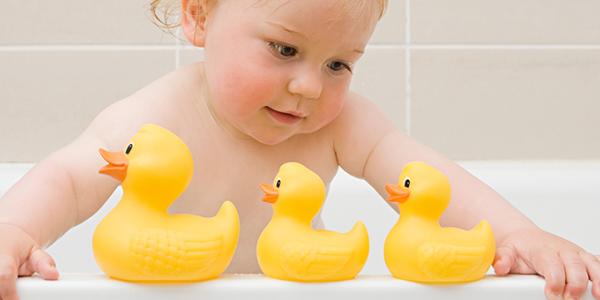Math in the Bath

You are here
By Sarah Erdmann
Bath time is perfect for exploring math with your young child! Not only do you have each other’s full attention, but the learning can be hands on, playful, and messy.
These explorations can also be done at a water table, sink, pool, or even a puddle! No matter what water spot you use, safety must be your main focus. Never ever leave your child alone, even for a minute! This is an activity that needs your complete attention.
Make sure that any toys or containers dry out completely between uses, and disinfect toys if several children will use them. Be sure to check toys for mold and replace them when needed. More detailed water safety tips can be found on the Red Cross’s website.
Infants and Toddlers
The very youngest mathematicians are learning what numbers are and that they mean something. Children are also learning to compare the shapes, colors and patterns they see.
Comparing and contrasting
Comparing and contrasting what is happening in the bathtub is a great place to start. It builds children’s math vocabulary and draws attention to what you're doing. “Your arm is dry. Now I’ll pour some water on it and your arm is wet!” “This cup is floating on the water. When we fill it up, it sinks to the bottom!” With these statements, you give your child a way to describe and compare those different states and shown them the step by step process for how it happened!
“I’m going to take the red square washcloth and dip it in the water. Now it is all wet so I can wash you!” By mentioning that the washcloth is square and red, your child sees two more ways to categorize it!
Counting
Count as you wash each part of your child's body. “One arm, two arms! You have two arms!” Count their fingers and toes, gently wash each ear. This repeated, concrete exposure to numbers will help her understand the concept of counting.
Exploring
Toddlers who are able to sit up and grasp objects can do some hands-on math learning as well! Offer different sized containers and encourage your child to use them to dump and pour water. “Now there is a lot of water in the red cup! The yellow cup has less water!” Your child is building her awareness of volume, while also strengthening her fingers and hands.
When you ask her to hand you something, describe the item. “Please hand me the hard, little, cup.” You can also ask your child to wash different parts of her body and help you count as she goes.
Without a lot of extra equipment or time, you’re showing your infant or toddler that math is useful and fun to explore.
Preschool
As children grow to preschool age, they build up their understanding of numbers. They are measuring, finding shapes and patterns, and even beginning to explore the concept of time. They’re also continuing to use math terms as they talk and categorize objects by different characteristics like shape, size and color.
A lot of the math play previously described for infants and toddlers is still great for preschoolers.
Give your child the washcloth and ask him to wash and count his body parts. Not only is he counting, but he's also using one-to-one correspondence, matching one object to another object, to make sure he washes all of his fingers and toes. Give your child containers of all shapes and sizes and let him pour, drip and measure. Ask him to describe what he's doing, the types of containers he has, and which ones have more or less water. You can even start to help him understand that if you pour water from a wide container into a skinny one . . . the amount of water doesn’t change! This is an idea that may be hard for young children to understand, so don’t worry if they don’t quite believe you.
At this age, children are more comfortable with the idea of measuring, so you can go farther with it. Give your child an old ruler so he can see how deep the water is. Discuss temperature and whether the water feels hot or cold. Have him see how many rubber ducks it would take to go across the whole tub.
Bath toys can be sorted or put into patterns. They can also be props in math games. For example, line up several rubber ducks and reenact the “Five Little Ducks” song:
Five little ducks went out one day, over the hills and far away
Mother duck said, “Quack, quack, quack, quack”
But only four little ducks came back . . . (Keep the song going until you reach zero ducks)
Math in the bath (don’t you like how that sounds?) is a chance for your child to play with math concepts and ideas. It also shows them what math can look like in the real world and how they might use it. And as an added bonus? They are squeaky clean by the end of the lesson!
Sarah Erdman is a mom, museum professional and early childhood educator. She teaches at FB Meekins Cooperative Preschool and is the founder of Cabinet of Curiosities LLC. Her research and professional practice explores how museums and educators can connect to make meaningful experiences for young children. She writes at cabinetofcuriositiesva.com/blog and tweets from @CabinetofCurios